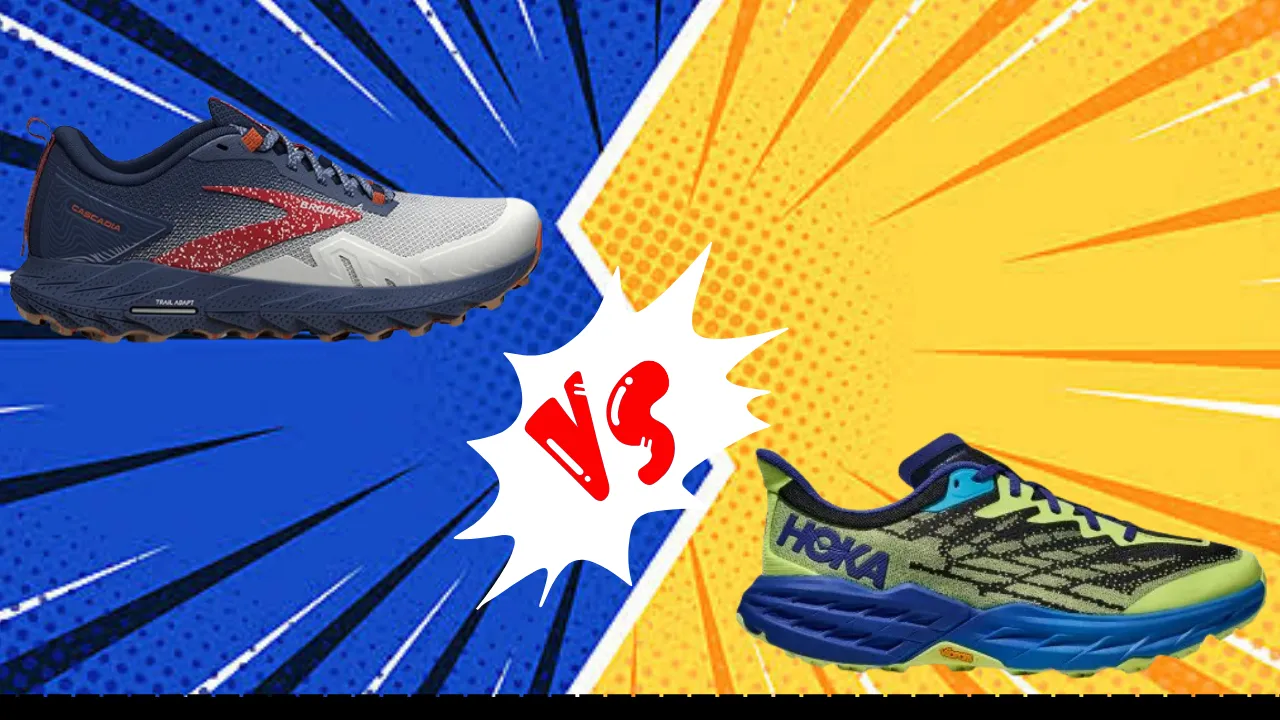With so many trail running shoes on the market, it can be tough to decide which model is right for your needs. Two of the top contenders are the Brooks Cascadia 17 and the Hoka One One Speedgoat 5.
Both shoes provide cushioning, support and traction for running on rugged terrain, but they have some distinct differences. This in-depth comparison highlights the key features, materials, performance and ideal uses for each shoe to help you determine which is the better option for your trail running goals.
Similarities And Differences Between Brooks Cascadia 17 and Hoka Speedgoat 5:
| Feature | Brooks Cascadia 17 | Hoka Speedgoat 5 |
|---|---|---|
| Launched In | 2023 | 2022 |
| Stability | GuideRails technology | J-Frame technology |
| Flexibility | Forefoot flex grooves | Flex grooves in outsole |
| Sizing | Men’s 7-13, Women’s 5.5-12 | Men’s 7-14, Women’s 5-13 |
| Weight | 10.6 oz (M), 9.8 oz (W) | 10.3 oz (M), 9.5 oz (W) |
| Cushion | DNA LOFT v3 foam | CMEVA foam |
| Outsole | TrailTack rubber | Vibram Megagrip |
| Midsole | BioMoGo DNA foam | PROFLY foam |
| Upper | Engineered mesh | Engineered mesh |
| Retail Price | $140 | $155 |
Features Comparison
Materials
The Cascadia 17 uses a durable TrailTack rubber outsole that provides excellent traction on varied terrain. The BioMoGo DNA foam midsole offers responsive cushioning that adapts to your stride. The engineered mesh upper is breathable while providing a secure foothold.


Meanwhile, the Speedgoat 5 utilizes a Vibram Megagrip outsole known for exceptional grip even in wet conditions. The PROFLY foam midsole delivers a lightweight and springy feel. Its engineered mesh upper balances breathability and foothold like the Cascadia.
Durability
In terms of durability, the Cascadia 17 comes out ahead. Its rugged TrailTack outsole holds up well to abrasive trail surfaces, while the BioMoGo DNA foam retains its lively cushioning even after many miles.
The Speedgoat 5’s Vibram Megagrip outsole provides traction for the long haul, but testers found the upper mesh on the Speedgoat frays more quickly than the finely-tuned mesh of the Cascadia. For the longest lasting trail companion, the Cascadia 17 is the winner for durability.
Fit
Both models provide a comfortable and secure fit for a variety of foot shapes, with integrated technology to lock the heel in place. The Cascadia 17 offers a roomier toe box with a fairly standard midfoot and heel.


while the Speedgoat 5 has a slightly wider platform throughout for more stability. The Speedgoat may work better for wider feet, but overall the Cascadia provides a more precision fit.
Stability
The core stability technologies make these shoes evenly matched for keeping feet protected and aligned on uneven terrain. The Cascadia 17’s GuideRails support and control excessive foot motion.
while the Speedgoat 5’s J-Frame reinforces the midsole to prevent rolling and slipping inside the shoe. Both are excellent choices for neutral runners needing a little extra stability due to the trail environment.
Cushioning
Plush cushioning for softening impact is where the Speedgoat 5 pulls ahead. Its CMEVA foam midsole provides superior shock absorption, especially when combined with the forgiving 4mm heel-to-toe drop.
The Cascadia 17 offers cushioned protection too with its DNA LOFT v3 foam, but testers found it slightly firmer than the pillowy Speedgoat. For the most cushy ride across rugged terrain, the Speedgoat 5 can’t be beat.
Value
With a $155 retail price, the Speedgoat 5 costs $15 more than the Cascadia 17. For runners prioritizing lightweight cushioning and enhanced grip on wet surfaces, the Speedgoat is likely worth the extra cost.
However, considering the comparable performance and superior durability of the Cascadia 17, its reasonable $140 price tag makes it the better value choice for most trail runners.
Performance Comparison
Walking
The Speedgoat 5’s plush CMEVA foam cushioning absorbs more shock when walking for long periods, reducing foot fatigue. However, the firmer BioMoGo DNA foam of the Cascadia 17 still provides comfort without as much instability when walking around technical trails. For paved walking, the Speedgoat has the advantage while the Cascadia excels for walking rugged topography.
Running
For a responsive and smooth trail running experience, the advantage goes to the Speedgoat 5. Testers found the PROFLY foam and 4mm drop translated to excellent energy return for running uphills and across varied terrain at all speeds. While the Cascadia 17 stabilizes well, its heavier weight doesn’t promote the same quick turnover.
Plantar Fasciitis
The Cascadia 17 provides superior arch support, keeping the plantar fascia tight and aligned inside the shoe thanks to GuideRails technology. This helps prevent exacerbation of plantar fasciitis symptoms during activity better than the Speedgoat 5. For runners with this foot condition, the Cascadia 17 is recommended over the Speedgoat.
Standing All Day
For occupations that require standing for long periods like retail or nursing, the Speedgoat 5 has the advantage. The plush CMEVA foam retains its shock absorption and energy return even when standing in one place, reducing discomfort better than the firmer Cascadia 17. Those on their feet all shift should choose the Speedgoat.
Final Verdict
In the end, choosing between these excellent trail running shoes depends on your specific needs and priorities. For runners wanting the best cushioned experience, smoothest ride, and value for the money, the Hoka One One Speedgoat 5 is the top choice.
However, if you prioritize durable construction, the most secure technical fit, and firm stability, the Brooks Cascadia 17 can’t be matched. Assess your individual running style, trails, mileage, foot shape, and any conditions to decide if the Speedgoat or the Cascadia will carry you to trail running success.
With this thorough comparison, you can confidently pick the ideal shoe to bring comfort, support and grip to all your rugged adventures.

